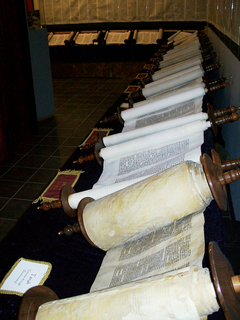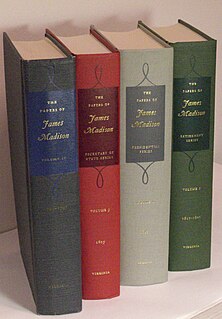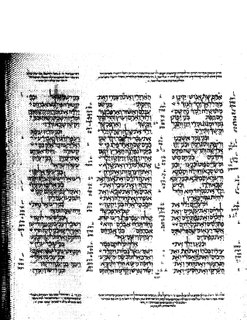
The Bible is a collection of religious texts, writings, or scriptures sacred to Jews, Samaritans, Christians, Muslims, and others. It appears in the form of an anthology, a compilation of texts of a variety of forms that are all linked by the belief that they are collectively revelations of God. These texts include theologically-focused historical accounts, hymns, prayers, proverbs, parables, didactic letters, admonitions, essays, poetry, and prophecies. Believers also generally consider the Bible to be a product of divine inspiration.

The Book of Genesis is the first book of the Hebrew Bible and the Christian Old Testament. In Judeo-Christian traditions it is viewed as an account of the creation of the world, the early history of humanity, Israel's ancestors, and the origins of the Jewish people. Its Hebrew name is the same as its first word, Bereshit.

The Old Testament is the first division of the Christian biblical canon, which is based primarily upon the 24 books of the Hebrew Bible or Tanakh, a collection of ancient religious Hebrew writings by the Israelites. The second division of Christian Bibles is the New Testament, written in the Koine Greek language.

Torah has a range of meanings. It can most specifically mean the first five books of the Hebrew Bible. This is commonly known as the Written Torah. It can also mean the continued narrative from all the 24 books, from the Book of Genesis to the end of the Tanakh (Chronicles). If in bound book form, it is called Chumash, and is usually printed with the rabbinic commentaries. If meant for liturgic purposes, it takes the form of a Torah scroll, which contains strictly the five books of Moses.

The Hebrew Bible or Tanakh, is the canonical collection of Hebrew scriptures, including the Torah. These texts are almost exclusively in Biblical Hebrew, with a few passages in Biblical Aramaic.

The documentary hypothesis (DH) is one of the models historically used by biblical scholars to explain the origins and composition of the Torah. More recent models include the supplementary hypothesis and the fragmentary hypothesis. All agree that the Torah is not a unified work from a single author, but is made up of sources combined over many centuries by many hands. These models differ on the nature of these sources and how they were combined.

Julius Wellhausen was a German biblical scholar and orientalist. In the course of his career, he moved from Old Testament research through Islamic studies to New Testament scholarship. Wellhausen contributed to the composition history of the Pentateuch/Torah and studied the formative period of Islam. For the former, he is credited as one of the originators of the documentary hypothesis.

The Bible has been translated into many languages from the biblical languages of Hebrew, Aramaic and Greek. As of September 2020 the full Bible has been translated into 704 languages, the New Testament has been translated into an additional 1,551 languages and Bible portions or stories into 1,160 other languages. Thus at least some portions of the Bible have been translated into 3,415 languages.
Partial Bible translations into languages of the English people can be traced back to the late 7th century, including translations into Old and Middle English. More than 450 translations into English have been written.
The Old English Bible translations are the partial translations of the Bible prepared in medieval England into the Old English language. The translations are from Latin texts, not the original languages.
Ælfric of Eynsham was an English abbot and a student of Æthelwold of Winchester, and a consummate, prolific writer in Old English of hagiography, homilies, biblical commentaries, and other genres. He is also known variously as Ælfric the Grammarian, Ælfric of Cerne, and Ælfric the Homilist. In the view of Peter Hunter Blair, he was "a man comparable both in the quantity of his writings and in the quality of his mind even with Bede himself." According to Claudio Leonardi, he "represented the highest pinnacle of Benedictine reform and Anglo-Saxon literature".
The Hexateuch is the first six books of the Hebrew Bible: the Torah (Pentateuch) and the book of Joshua.

The Law of Moses, also called the Mosaic Law, primarily refers to the Torah or the first five books of the Hebrew Bible. They were traditionally believed to have been written by Moses, but most academics now believe they had many authors.

A tetralogy, also known as a quartet or quadrilogy, is a compound work that is made up of four distinct works. The name comes from the Attic theater, in which a tetralogy was a group of three tragedies followed by a satyr play, all by one author, to be played in one sitting at the Dionysia as part of a competition.

The genealogies of Genesis provide the framework around which the Book of Genesis is structured. Beginning with Adam, genealogical material in Genesis 4, 5, 10, 11, 22, 25, 29-30, 35-36, and 46 move the narrative forward from the creation to the beginnings of Israel's existence as a people.
Martin Noth was a German scholar of the Hebrew Bible who specialized in the pre-Exilic history of the Hebrews and promoted the hypothesis that the Israelite tribes in the immediate period after the settlement in Canaan were organised as a group of twelve tribes arranged around a central sanctuary on the lines of the later Greek and Italian amphictyonies. With Gerhard von Rad he pioneered the traditional-historical approach to biblical studies, emphasising the role of oral traditions in the formation of the biblical texts.
Prolegomena zur Geschichte Israels is a book by German biblical scholar and orientalist Julius Wellhausen (1844–1918) that formulated but did not found the documentary hypothesis, a theory on the composition history of the Torah or Pentateuch. Influential and long debated, the volume is often compared for its impact in its field with Charles Darwin's 1859 work, On the Origin of Species.

The Old English Hexateuch is the collaborative project of the late Anglo-Saxon period that translated the six books of the Hexateuch into Old English, presumably under the editorship of Ælfric of Eynsham. It is the first English vernacular translation of the first six books of the Old Testament, i.e. the five books of the Torah and Joshua. It was probably made for use by lay people.

A Protestant Bible is a Christian Bible whose translation or revision was produced by Protestants. Such Bibles comprise 39 books of the Old Testament and 27 books of the New Testament for a total of 66 books. Some Protestants use Bibles which also include 14 additional books in a section known as the Apocrypha bringing the total to 80 books. This is often contrasted with the 73 books of the Catholic Bible, which includes seven deuterocanonical books as a part of the Old Testament. The division between protocanonical and deuterocanonical books is not accepted by all Protestants who simply view books as being canonical or not and therefore classify books found in the deuterocanon, along with other books, as part of the Apocrypha.

1 Chronicles 2 is the second chapter of the Books of Chronicles in the Hebrew Bible or the First Book of Chronicles in the Old Testament of the Christian Bible. The book is compiled from older sources by an unknown person or group, designated by modern scholars as "the Chronicler", and had the final shape established in late fifth or fourth century BCE. This chapter and two subsequent ones focus on the descendants of Judah, where chapter 2 deals with the tribe of Judah in general, chapter 3 lists the sons of David in particular and chapter 4 concerns the remaining families in the tribe Judah and the tribe of Simeon. These chapters belong to the section focusing on the list of genealogies from Adam to the lists of the people returning from exile in Babylon.











